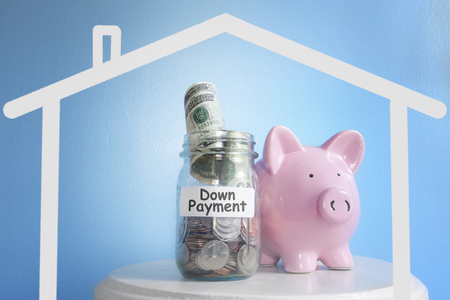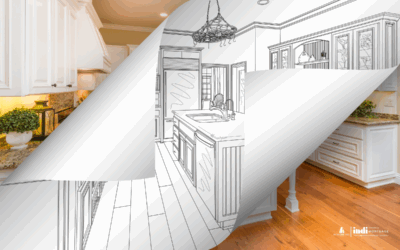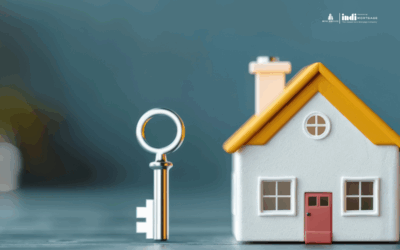Welcome To Our Mortgage Educational Blog About:
The Risks and Benefits of a 5% Down Payment

A down payment is a percentage of the purchase price that is required to be paid upfront when a buyer intends to secure a home loan otherwise known as a mortgage. Down payment tends to fluctuate depending on the buyer’s type of mortgage. It is crucial to understand what a down payment is and how to go about it to avoid inconveniences and confusion in the future.
Normally, the expected guideline required for a down payment on a new house lies anywhere from 5% to 20%. However, this is a significant amount of money for most people, particularly first-time homebuyers. The 20% down payment is the most common because it is the amount home buyers are required to avoid mortgage insurance, which can cost up to approximately 4% of the loan amount.
Even though the figure of 20 % comes off as ideal, it is not realistic for all clients and is not compulsory. Regardless of the progressive increase in the cost of a new house, the average down payment is usually as little as 5%. The 5% comes off as something that first-time homebuyers can realistically bring forth. Another major contributing factor is the client’s financial situation, income stability, and credit score. A higher credit score means that the person(s) can raise a substantial down payment.
Just like most things in life, the 5% down payment strategy comes with its risks and benefits that are discussed below:
The benefits of a 5% down payment
Some of the benefits associated with a 5% down payment include:
1. Not much of a deposit is required
It sounds great because one does not have to drain all their savings to secure their down payment. The low down payment gives room for the buyer to deal with other bills and expenses or repairs needed in the household. For instance, if you are buying a house with a 5% down payment, you may need to replace the doors, but you have some money left to do so.
2. You may be capable of making a purchase sooner
A 5% down payment gives room for more buyers to purchase homes and more sellers to make sales. In addition, a lower down payment makes it way easier to buy a house months or even years earlier.
3. It can strengthen the market
As stated earlier, the 5% down payment gives room to have more buyers and sellers. Therefore, the business does not get stagnant. The buyers can therefore purchase and renovate the houses, and sell them to other buyers in the future.
4. You can fix your payments for 5 years
A fixed rate for the loan allows you to align your expenses and have peace of mind knowing that the payment will not change for around five years. This allows you to work towards better financial management and a larger down payment for your next home.
The risks of a 5% down payment
Some of the risks associated with a 5% down payment include:
1. Paying more interest rate
From a mathematical perspective, it is pretty evident that the lower the down payment, the larger the amount left to be divided monthly into the mortgage. In other words, you will be paying more interest during the period of the mortgage which could cost more than the original amount.
2. Negative equity
Equity is the difference between the current market value of a house and the amount a homeowner is supposed to pay on the mortgage. More often than not, owning a house is seen as a chance for a solid investment because one can build equity.
However, as a buyer, you will only have a 5% stake in your house when purchasing with the 95% loan; therefore, you are very likely to face the risk of negative equity. Negative equity is normally a problem if you need or want to resell or remortgage; but if you pay the home loan progressively, your equity and stake in your house tend to increase.
3. It will be more difficult to remortgage
As you pay your home loan, the loan-to-value i.e., LTV tends to decrease. If you begin with a 95% home loan, it may take a while to lower the LTV to a point that you are qualified for even more competitive rates if you want to remortgage. Furthermore, if your property has depreciated in value and you are in negative equity, it will be impossible to remortgage.
4. You may end up overstretching yourself
Although you pass the affordability test presented to you by the lender, take note that interest rates will increase. Therefore, if your circumstances were to shift in the future, you may end up struggling to pay off a large sum of the mortgage.
5. You will require mortgage insurance
When a buyer puts anything less than a 20% down payment on a mortgage, they will be expected to pay mortgage insurance. Mortgage insurance is a specified amount paid upfront or monthly to the lender to protect the home loan just in case you happen to default on your mortgage. The additional payment of the mortgage insurance can add up to even 4%. However, note that you can cancel the insurance immediately after you get to 20% equity in your home.
6. Weakens your negotiating power among sellers
In case you intend to buy a home, you need to understand that presenting a low down payment such as 5% can weaken your negotiation strategy. As a result, you may end up losing out on a home or two due to a low competitive edge. This is because sellers are usually more willing to engage with able buyers who compete for houses. The buyers may present higher down payments than your own which gives them more favor and advantage over the seller.
Conclusion
Your down payment amount can seriously affect your home buying process. A 5% down payment may not be the ideal approach for every individual. Therefore, it is important to understand what kind of mortgage is suitable for you, along with its risks and benefits to come up with informed choices. In case you are uncertain, it is best to consult an experienced real estate agent or an Edmonton Mortgage Broker.
Are you ready to purchase a home? Reach out to me directly or start your application here: www.sandraforscutt.ca/mortgage-application/
Don’t hesitate to contact us with any questions you may have.
Recent Educational Blogs
Thinking About Flipping a House in Edmonton?
May 2025 | Flip Mortgage ProgramAre you eyeing that “fixer-upper” in Edmonton and dreaming of turning it into a showstopper? House flipping is more popular than ever, and with the right mortgage program, it’s easier to get started than you might think!What is a Flip...
Unlocking the Value in Your Home
April 2025 | Home Equity Unlocking the value in your home can be a smart way to fund major renovations or get a handle on high-interest debt. If you’ve built up equity—the difference between your home’s current value and what you still owe on your mortgage—you may be...
To Refinance or Not to Refinance: Navigating Mortgage Renewal in 2025
March 2025 | To Refinance or Not to RefinanceAs mortgage renewal season approaches, many homeowners are grappling with a critical question: Should I refinance my mortgage? With interest rates higher than what many locked in years ago and looming financial pressures...



